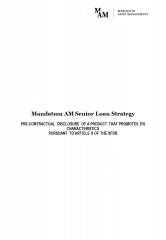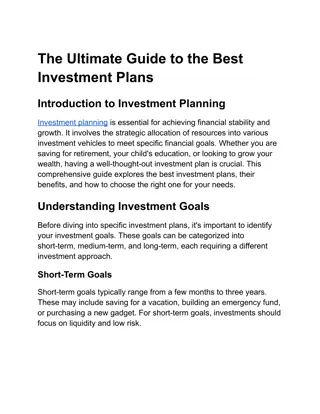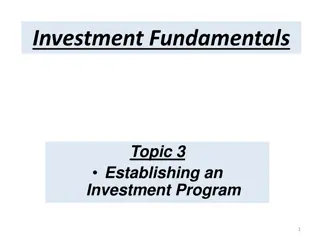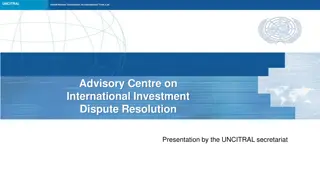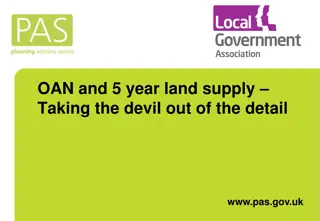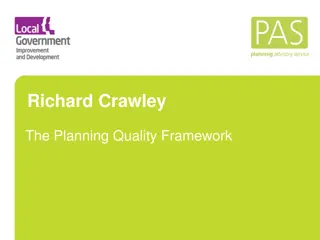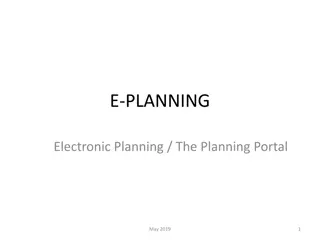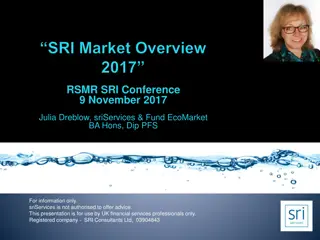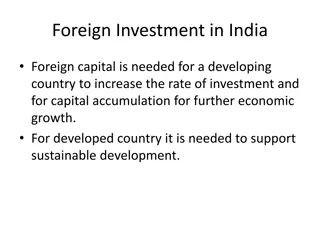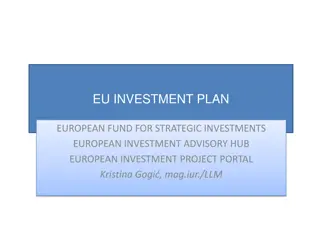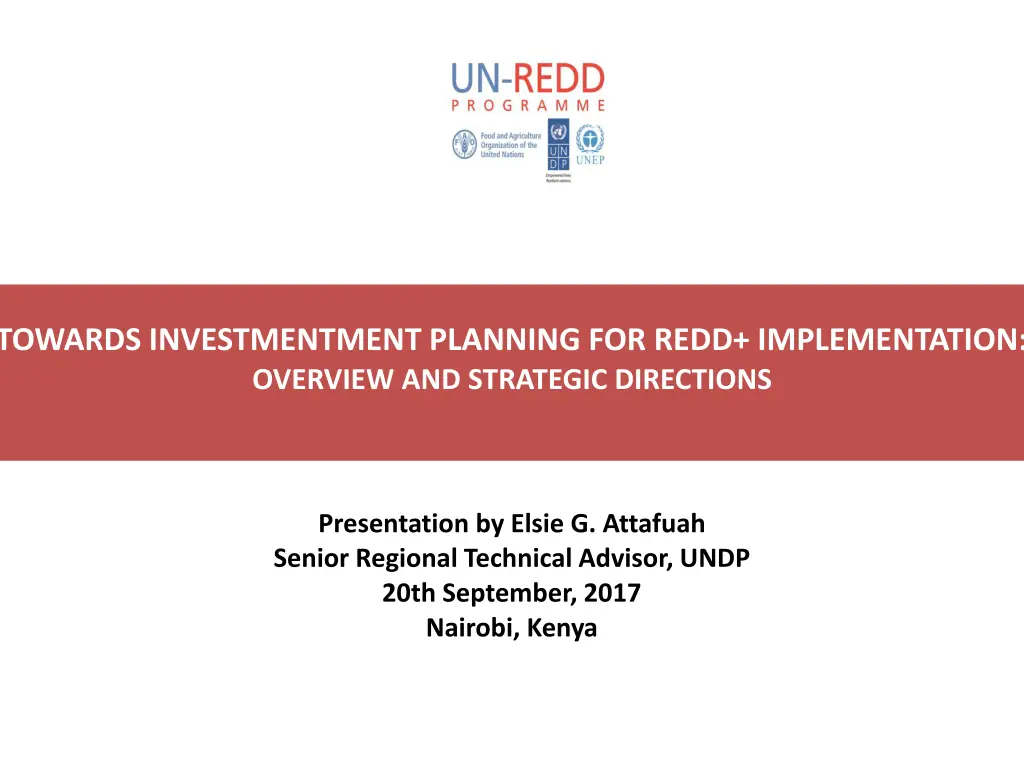
Strategic Directions for REDD+ Investment Planning
Explore the essential aspects of REDD+ Investment Planning, including objectives, development process, and key components such as theory of change and resource mobilization. Learn how Investment Plans facilitate policy implementation, mobilize finance, prioritize investments, and encourage transformational change in the forest sector.
Download Presentation

Please find below an Image/Link to download the presentation.
The content on the website is provided AS IS for your information and personal use only. It may not be sold, licensed, or shared on other websites without obtaining consent from the author. If you encounter any issues during the download, it is possible that the publisher has removed the file from their server.
You are allowed to download the files provided on this website for personal or commercial use, subject to the condition that they are used lawfully. All files are the property of their respective owners.
The content on the website is provided AS IS for your information and personal use only. It may not be sold, licensed, or shared on other websites without obtaining consent from the author.
E N D
Presentation Transcript
TOWARDS INVESTMENTMENT PLANNING FOR REDD+ IMPLEMENTATION: OVERVIEW AND STRATEGIC DIRECTIONS Presentation by Elsie G. Attafuah Senior Regional Technical Advisor, UNDP 20th September, 2017 Nairobi, Kenya
Outline 1.IP in the REDD+ planning pathway 2.Objectives of the Investment Plan (IP) 3.IP versus a National REDD+ Strategy 4.An example of IP development process 5.Experiences and lessons learned
What is an Investment Plan (though can be called anything else relevant for the country ) An Investment Plan is to generally help to 1. Facilitate the implementation of policies and measures identified in national REDD+ Strategy; 2. Mobilize the requisite financing and investments associated with the implementation of the strategy;
3. Define, scope and prioritize key investments as well as the associated costs; 4. Encourage programmatic investments aimed at transformational change in the forest sector and other sectors that affect forests.
Developing a robust national REDD+ Investment Plan, includes: A robust theory of change. A detailed action plan, including leading and contributing agencies and stakeholders, scope and scale, volume of activities and timeline, quantified targets, expected carbon and multiple benefits, risk assessment and provisions to respect and monitor REDD+ safeguards, financial needs and respective sources and modalities. Overarching resource mobilization framework. A robust monitoring and evaluation framework.
The Place of IP in the REDD+ Planning pathway: From strategic planning to implementation From a NS/AP to actual investments in the field, intermediate steps are likely to be required More strategic More operational Optional programming intermediate steps (likely necessary, though depending on country context) UNFCCC Warsaw Framework (requirement for access to RBPs) Implementation & (or) National Investment Plan NRIP REDD+ National Strategy REDD+ national Action Plan National level or Investments (National &/or subnational Programmes &/or Sectoral Plans (?) &/or Subnational Action Plans (?) Subnational level Resource mobilization Resource mobilization Resource mobilization
National REDD+ Strategy vs. Investment Plan Some general distinctions (though varies ) Strategy Plan Political document Operationalizes the Strategy (detailing it) (Semi-political / Semi-technical) Shorter/medium-term (e.g. 5y) Medium/long-term vision (e.g. 10y or open-ended) clearquantitative objectives over a specific timeline throughpackages of interventions that have been costed with (some) financial resources identified &/or secured/ and/or pulled M&Ed using a clear results framework withperformance indicators with risks identified & managed. General strategic priorities to achieve vision and goals (list of PAMs) Not a new Policy Framework to ensure coherence & cost-effective implementation, reaching multiple objectives
NRIP: Pulling resources Norway phase 2 & 3 International REDD+ Finance (GCF, bi/multilaterals) ERPD RBPs (UNFCCC) ODA REDD+ Investment Plan Agriculture Forestry Energy . Non-REDD+ Finance (but REDD+ relevant) Private sector Agriculture Forestry Energy . National budget NRIP: Pooling & coordinating investment
Financial instruments Depending on PAMs: Best financial instruments? (e.g. grants, loans, guarantee) Recipients? (e.g. governmental entities, private sector, households) Intermediaries? (e.g. Investment banks, etc) Mechanism? (e.g. Inter-governmental transfer) Impacting Financial mechanism(s) Entities that need to be involved in design
Results Framework Develop the results chain / indicators / targets (C / NCB) based on the TOC Relevance to REDD+ MRV (Forest cover / GHG) Impact Outcome 1 M&E NFMS Output 1.1 (e.g. A/R) Input 1.1.1 = PAMs Level of control
PAMs implementation and M&E Define tools, systems & processes to collect, aggregate, transfer, analyze & report on data Data transfer, aggregation & analysis Data National level Collection Oversight Need to clarify what info needed at which level(s) Integrate with Government systems / assess gaps Define if/how to address gaps cost-effectively Ensure aggregation (incl. cross-sectorial coherence!) Includes safeguards (part of SIS ) Implementation Provincial level Oversight Implementation Local level Implementation
Ensuring coherence & synergies in implementation (e.g. DRC) National REDD+ Strategy 2012 Nat. REDD+ Investment Plan 2015-2020 2013 2015 FIP 2016 CAFI LoI ERPD GCF proposal REDD+ Strategy / Investment Plan ImportantCoordination Fundraising tools!! National REDD+ Fund
Investment Plan Structure (e.g. DRC) Main document Appendix Introduction (REDD+ process) Objectives & Principles Implementation framework Alignment with wider national priorities NDP, Governance matrix, INDC Context Drivers, stakes TOC (narrative + graph) Types of investments Enabling/Sectoral Thematic/Integrated Complementarities / Alignment Matrix contribution prog to drivers Geographical priorities Results framework Budget Risk management framework Programs profiles Consultations Priority areas (details) Alignment of existing investments (details) Mapping of existing interventions Local communities, IPs & role of civil society Role of private sector NFMS etc
Theory of change (e.g. DRC) With a narrative
Approach of intervention (e.g. DRC) National sectorial programmes (incl. reforms) 2 main approaches Ensuring synergies between programmes: Geographically Thematically while managing inter-dependency (risk) Governance Demography Land Use plans Tenure Agriculture Energy Forest Zone A Governance Demography Land Use plans Tenure Agriculture Energy Forest Zone B Large-scale subnational programmes
Need for strong political commitment and stakeholder engagement Ensure key decision makers are aware and involved Ensure key stakeholders including CSOs and private sector are involved Define clearly the objectives and scope of the IP: Taking into account existing initiatives, institutional structure of the country etc Ensure that the name used (investment / implementation / operational Plan) is well understood and consensual
Ensure a strong work stream on financial strategy Goes beyond costing into actual identification of potential financial sources (domestic/international, public/private), and defining priorities + strategies to actually engage these sources Should look at the broad spectrum of financial instruments, depending on the type of costs/actors involved/opportunities If GCF is one of the sources identified, its requirements may a good way to structure and push for a high quality process (linking GCF/Investment planning processes to save costs)
Important to clearly prioritize investment, even if keeping the whole scope of the NS/AP: Should take into account the financial strategy Important elements for implementation to think of/work on in parallel (beyond WF), ensuring the essential linkages: M&E system for REDD+ implementation (integrated into existing government systems, including relevant linkages with SIS/NFMS) Financial mechanism (if relevant, depending on financing strategy, objectives for RBPs, etc)
TALK SHOW ON INVESTMENT PLANNING WITH COTE IVOIRE, ETHIOPIA, GHANA AND ZAMBIA Hosted by Wahida Shah, Technical Specialist, UNDP 20th September, 2017 Nairobi, Kenya
Guiding Questions 1. Cote d Ivoire: How have you ensured coherence between developing your National REDD+ Strategy, the National Investment Plan and the development of an investment proposal to GCF? How have these processes benefitted from each other in terms of synergies? 2. Zambia: Kindly share Zambia s experiences, lessons and key messages on how you worked with various stakeholder and partners in defining your investment priorities? More, specifically, how did your coordinate multi-lateral development partners efforts in the investment plan development? What is the outlook in terms of facilitating the implementation of the investment plan including mobilizing resources?
Guiding Questions 3. investment planning through the CRGE Strategy and CRGE Facility, and most recently the Forest Sector Development Programme and the Investment proposal submitted to the Government of Norway under the bilateral Agreement with Norway. How did you go about prioritizing investments amongst the many priorities Ethiopia has, how you worked with various stakeholder and partners in defining these priorities, and how did you cost and budget for these investments? Ethiopia: Ethiopia has gone through
Guiding Questions 4. Investment plan in the coming months? How does the country intend to go about this, drawing lessons from other countries? Ghana: Ghana intends to develop an
Asante Sana Asante Sana For more information, contact: Elsie Attafuah, Senior Regional Technical Advisor, UNDP Elsie.attafuah@undp.org Acknowledgements: Bruno Hugel, REDD+ Technical Advisor, UNDP bruno.hugel@undp.org Wahida Shah, Technical Specialist, UNDP Wahida.shah@undp.org Ela Ionescu, Country Support Specialist, UNDP Ela.ionescu@undp.org

